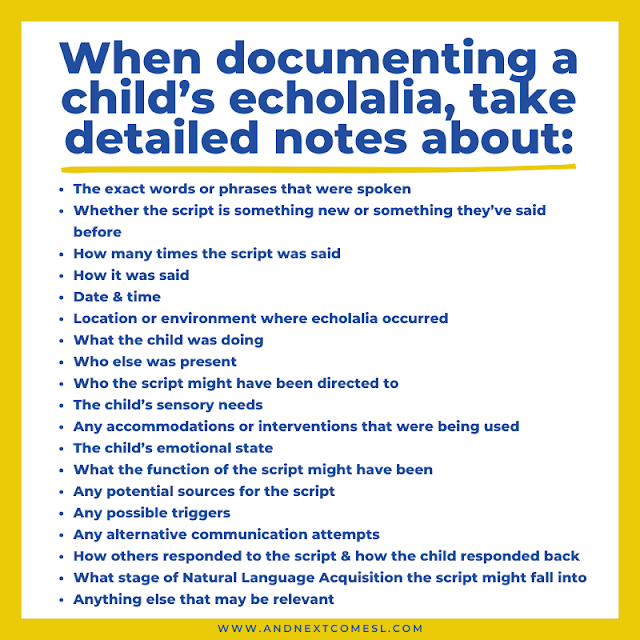If you have a gestalt language processor or hyperlexic child, then you know that echolalia is an important part of their language development.
You might also know that you can't always take echolalia literally. Sometimes, you have to do some detective work to find out the underlying meaning and communicative functions.
That's why it's so important to track echolalia and the scripts a child uses in the first place. It can provide you with so much valuable information.
But how to do you go about tracking echolalia or language gestalts? What kind of information should you include when making notes? How should you organize the information? It might seem a bit overwhelming to get started.
Well, that's where these tips for tracking echolalia come in. They should help you get started with documenting a child's language skills.
Tips for Tracking Echolalia & Scripts
The best place to start tracking is to simply observe and start documenting. You can use something like these echolalia tracking sheets or a notebook. You could also try a note taking app, Google doc, or Google spreadsheet to make notes. These methods will allow you to track echolalia while on the go, which can be handy.
When documenting the scripts that a gestalt language learner uses, you'll want to take detailed notes. Try to include as much specific information as possible, such as or including the following:
- The exact words or phrases that were spoken
- Whether the script is something new or something they've said before
- How many times the script was said
- How it was said (e.g., consider intonation and speed, was it all clear?)
- Date and time
- Location or environment where echolalia occurred
- What the child was doing (i.e., the activity or context)
- Who else was present, if applicable
- Who the script might have been directed to, if applicable
- The child's sensory needs
- Any accommodations or interventions that were being used
- The child's emotional state (e.g., were they anxious, sad, angry, happy, playful, etc.?)
- What the function of the script might have been (e.g., to regulate, to label, or to protest)
- Any potential sources for the script (e.g., something someone said, a line from a book or movie, a recent event)
- Any possible triggers (e.g., a change in routine)
- Any alternative communication attempts (e.g., gestures, sign language, an AAC device)
- How others responded to the script and how the child responded back (e.g., repeated the script back to the child and then the child made eye contact or smiled)
- What stage of Natural Language Acquisition the script might fall into (you might want to consult with an experienced speech therapist for this)
- Anything else that may be relevant
You might also want to consider recording, either audio or video, any play sessions (if you are a parent) or therapy sessions (if you are a therapist). That way you could transcribe or re-watch the sessions later. Who knows, you might pick up on more subtle cues or information that you might otherwise miss. It will also let you review the musicality, intonation, pitch, and speed of the echolalic phrases.
You might also find it helpful to collaborate with others. For instance, you might want to consult with a speech therapist, especially one familiar with gestalt language processing and Natural Language Acquisition.
Your notes can be helpful for therapists to determine what stage of language development a child is in and help the therapist better connect with the child during speech therapy sessions. And you might be able to help them determine the source of any scripts used in therapy that they might not be familiar with.
You might also want to chat with the child's teacher, classroom aide, daycare workers, other professionals, family members, or anyone else who might regularly interact with the child. They might be able to help determine where specific scripts come from, their possible functions, and their possible meanings.
It can also be helpful to keep in mind a child's interests and media consumption. Are there specific shows, songs, movies, or books that they watch or read quite frequently? Knowing this information can make it so much easier to identify the possible source for some of the scripts a child uses. So you might find it helpful to make a list of things they watch, read, or listen to on a regular basis.
Need an Easy Way to Track Echolalia & Scripted Phrases?
That's where these echolalia tracking sheets come in handy. There's even a digital spreadsheet version included if you'd prefer to be able to do it while on the go.
Grab your copy of the echolalia tracking sheets
A Quick Summary of Tracking Echolalia
Just to recap, here are the main echolalia tracking tips to keep in mind:
- Observe & document
- Take detailed notes
- Use an echolalia tracking sheet, a notebook, an app, a Google Doc, a spreadsheet, or whatever works best for you
- Consider recording sessions, either audio or visual
- Collaborate with others
- Consider the child's interests and media consumption
I hope you found these tips for tracking echolalia and scripts helpful.


